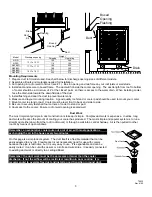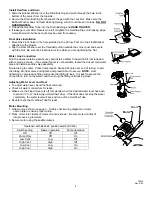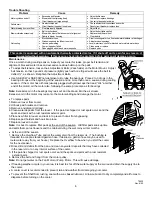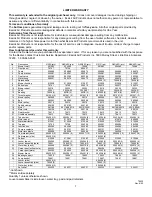
Roof Jack
Weight
Model Discharge
opening
Shipping Operating
N31D 150
245
N30S
13 ¾” x 13 ¾”
115 195
N43/48D 190
325
N40/45S
17 ¾” x 17 ¾”
185 300
N56/66D 211
340
N55/65S
19 ¾” x 19 ¾”
203 375
Flashing
Boxed
Opening
Roof
Kit
Drain
Duct
Drain
Flashing
Duct
Boxed
Opening
Mounting Requirements
1. Prepare duct to fit model used. See chart below for discharge opening sizes of different models.
2. Assemble all tools and materials needed for installation.
3. Cut opening in roof or wall to fit duct (see # 1). Box in opening and reinforce any cut roof joists or wall studs.
4. Install duct and secure to boxed frame. The duct will fit inside the cooler opening. The duct length from roof to bottom
of cooler should be a minimum of 4” at the closest point, so there is access to the water drain. When installing cooler,
face the drain side toward the downhill side of the duct.
5. Install flashing and seal the duct to prevent water entry.
6. Measure and layout mounting location. A good quality roof stand or cooler pad should be used to mount your cooler.
7. Mount cooler to stand or pad. Cooler must be level front to back and side to side.
8. Be sure to securely fasten all four corners of cooler to stand or pad.
9. Caulk duct to the cooler. Ensure roof or wall opening is sealed well.
Duct Work
The most important principle in duct construction is to keep it simple. Complex duct work is expensive. In attics, long
duct work will reduce the amount of cooling your cooler has produced. The most simple and popular system is to run a
straight duct either down from the roof (roof mount) or through a wall into a central hallway. Air is then pulled to other
rooms by means of open windows.
Remember, an evaporative cooler puts out a lot of air, with most applications
exchanging the air in the house every two minutes.
On this page is a simple duct system. The duct itself is a flexible material that can be
easily adapted to any job. Flexible duct is not necessarily good for use with coolers
because the pipe is restrictive, but it is very easy to use. It is expandable and can be
easily routed. It can be cut with scissors or a knife and wire snips. It is easily connected
to existing duct work or directly to a ceiling diffuser.
Remember: the duct work must be the same size or larger than the cooler
discharge. If not the airflow will be restricted, resulting in poor cooling. It is
recommended to oversize flex duct and install a good transition in round duct.
70932
Rev. 6/02
3


























